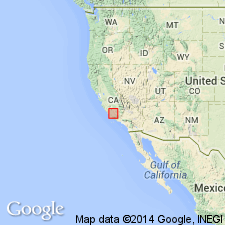
- Usage in publication:
-
- Cymric Shale Member*
- Modifications:
-
- Named
- Dominant lithology:
-
- Shale
- AAPG geologic province:
-
- California Coast Ranges province
Summary:
Pg. 20. Cymric Shale Member, lowermost of 7 members of Temblor Formation. Commonly known as Salt Creek Shale (Williams, 1936; Goudkoff, 1943), but this name is preoccupied, so it is renamed Cymric Shale Member. Composed of dark-gray clayey to silty shale. Is 74 feet (23 m) thick at type, ranges several hundred feet in subsurface. Disconformably overlies Point of Rocks Sandstone. Conformably underlies Wygal Sandstone Member (new) of Temblor Formation. Contains sparse foraminifers of late Oligocene (Zemorrian) age. Age of Cymric is considered late Oligocene. (Cymric Shale Member of Temblor Formation adopted by the USGS.)
Type section: exposures in Zemorra Creek, in sec. 9, T. 29 S., R. 20 E., Carneros Rocks quadrangle, Temblor Range, Kern Co., southern CA. Named from nearby Cymric oil field.
Source: GNU records (USGS DDS-6; Menlo GNULEX); Changes in stratigraphic nomenclature, 1973 (USGS Bull. 1395-A, p. A12-A13); US geologic names lexicon (USGS Bull. 1520, p. 78).
For more information, please contact Nancy Stamm, Geologic Names Committee Secretary.
Asterisk (*) indicates published by U.S. Geological Survey authors.
"No current usage" (†) implies that a name has been abandoned or has fallen into disuse. Former usage and, if known, replacement name given in parentheses ( ).
Slash (/) indicates name conflicts with nomenclatural guidelines (CSN, 1933; ACSN, 1961, 1970; NACSN, 1983, 2005, 2021). May be explained within brackets ([ ]).

